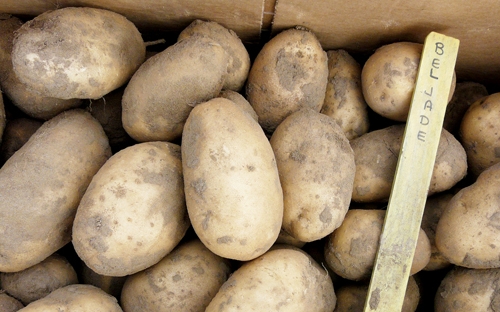
Features
Agronomy
Soil
Promising new potato varieties
Selecting suitable varieties is an essential first step in any successful potato operation. Varieties not only must suit the intended market but must also be well adapted to local growing conditions. Hundreds of varieties are available to potato growers, but as few as 10 account for approximately 90 percent of the Ontario acreage.
June 10, 2013 By Eugenia Banks Potato specialist OMAFRA
 The Beljade variety was outstanding in the Grand Bend Selecting suitable varieties is an essential first step in any successful potato operation. Varieties not only must suit the intended market but must also be
The Beljade variety was outstanding in the Grand Bend Selecting suitable varieties is an essential first step in any successful potato operation. Varieties not only must suit the intended market but must also beThe goal of potato breeders is to develop new varieties that are attractive, high yielding and pest resistant in the traditional classes: table-stock, processing and/or specialty markets.
This is no small task and involves the following strategies:
- Use improved potato germplasm to reduce the impact of economically important potato pests
- Evaluate advance breeding lines for yield, quality and pest resistance at multiple locations
- Conduct commercial trials of advanced potato breeding lines to facilitate the adoption of new varieties
- Provide relevant information on the performance of new potato varieties to potato growers, crop consultants and extension personnel
It usually takes plant breeders 12 to 15 years to develop, evaluate and release a new potato variety. Variety trials in growers’ fields are extremely important for breeders and growers. It is the final test for a variety. New varieties may perform very well in a certain production area but they might not do well in a neighbouring area due to different growing conditions such as microclimate and soil type. This is the case with the variety called Shepody that grew very well in the Shelburne area but did very poorly in the Alliston area. The distance between these two areas is only 30 kilometres.
In 2012, new varieties released by several breeding programs were evaluated in trials conducted in growers’ fields in Shelburne, Delhi and Grand Bend, Ontario. Many of these new varieties did not perform well, but a few received good reviews by growers based on their yield and appearance. This past season was tough, due to the hot and dry weather. Varieties that performed well are good candidates to become commercial releases in Ontario.
In the Shelburne area, Clearwater Russet was the best performer. The yield was close to 300 cwt. It is a medium-late variety with oblong to long tubers that have medium russet skin and shallow eyes. It sets eight to nine tubers per hill and is resistant to scab. According to the Potato Variety Management Institute, which is the agent for this variety, the tubers exhibit excellent fry colour out of storage and their attractiveness make this variety suitable for both processing and fresh market usage.
Clearwater Russet is also notable for having higher protein content than standard potato varieties, and has 38 percent higher protein content than the Russet Burbank.
Once a variety performs well in the field, it needs to be evaluated in storage to complete the variety profile. At this point, I can say Clearwater looks promising for the Ontario market.
In the Delhi area, the potato selection ND 8555-8R, a round, red-skinned selection with white flesh, did very well. Maturity is medium to full season. The Simcoe-Delhi area was hit hard by the hot, dry weather this past summer. A potato selection that performs well and does not develop off-shaped tubers, growth cracks or second growths is very promising for that area. Unfortunately, it is susceptible to scab.
I have grown ND 8555-R for three years now and it stores very well. Skinning is not a problem as long as it is not dug for at least 14 days after top killing.
ND 8555-8R was developed in North Dakota. It appeared in the 2012 list of seed potatoes certified in Maine. Therefore, seed should be available for the 2013 season.
In the Grand Bend area, Beljade, a high yielding, oblong, white variety, was outstanding. It did not develop off-shaped tubers, second growth or growth cracks. It has some tolerance to scab. Storability and after-cooking darkening are factors to be determined. This variety has been available from La Patate Lac St. Jean since this past spring.
Print this page